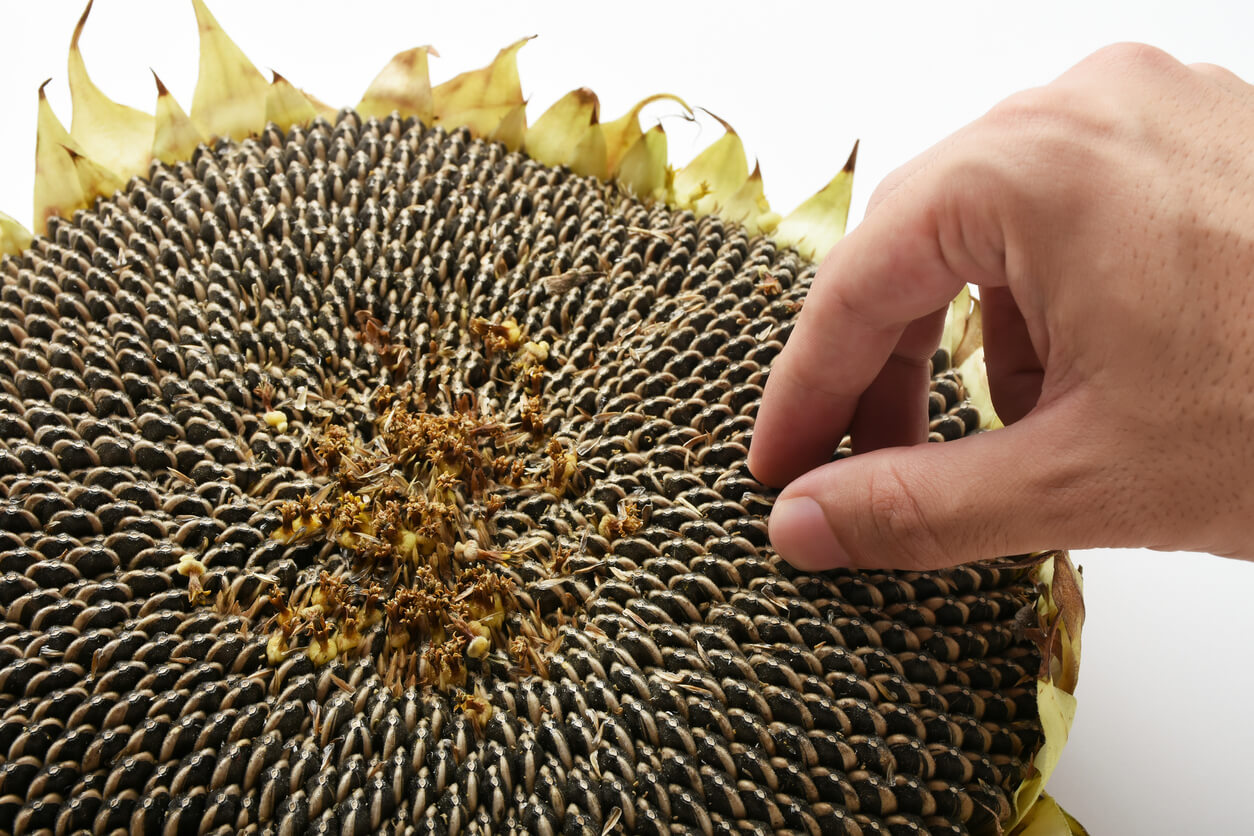
Gardener handpicking sunflower seeds from a dried seed head
Storing and preserving sunflower seeds is pretty straightforward, depending on whether you plan to eat them or if you’re going to share them with local wildlife.
The simplest thing to do is cut the ripe sunflowers off the stalk, remove the flower ray petals, and set the sunflowers out where birds and other wildlife can enjoy them. If you want to enjoy them for yourself, there are a few other steps to take.
When the surface of the sunflower is clear of disc flowers, tie two or three sunflowers together and hang them in a dark, warm, dry area for a few days up to week. To keep things neat, tie cheesecloth, a paper bag, or a mesh laundry bag over the head to catch any seeds that fall out, and to protect your seeds from hungry critters.
Once the seed heads have dried, it should be easy for you to loosen the seeds from the head. Then you’re ready to preserve them.
Soak and salt your sunflowers
The first step toward getting your sunflowers ready to eat is to soak them in a salt bath overnight. This will draw out impurities and plump up your seeds for whatever comes next.
After a good soak, strain your sunflower seeds. Pick out any debris. Spread the seeds out in a single layer on paper towel or some other absorbent surface until they are completely dry.
Choose your sunflower style
Once your soaked and salted sunflowers are dry, you have a number of ways you can enjoy them: raw or roasted, in their shells or out.
Raw sunflowers
Once your sunflower seeds are dry, spread them out on a flat, borderless surface like a countertop. Make sure the seeds are on some sort of liner, like waxed paper or parchment paper. This is where things will get a little messy, but not for long.
Roll a rolling pin over the seeds to separate them from the shells. You can also use a kitchen mallet or the broad side of a chef’s knife. To make the sorting easier, dump the shells into a large jar of water and pour the floating debris into the compost. Keep pouring water into the jar until all the flotsam is removed and you have nothing left but kernels.
Store in an airtight container for up to two weeks, or in the fridge for up to a month.
Roasted sunflowers
If you don’t want to eat your sunflower seeds raw, fire up the oven to 325 degrees F. Spread your sunflower seeds, still in their shells, on a parchment-lined baking sheet. Drizzle with oil and a little salt or a seasoning of your choice. Bake the seeds for 30 to 40 minutes, stirring and flipping them about halfway through.
Let the seeds cool. At this point, they’re ready for snacking—especially if you enjoy the fun of cracking the shells with your teeth, spitting out the shells, and savoring each seed.
If you’d like a less messy way of eating them, remove the seeds from the shells as described above. Store in an airtight container and use for snacks and baking.
Sunflower seed butter
You can also take your freshly roasted and shelled seeds and transform the seeds into sunbutter. It’s as easy as running a batch of seeds on high in the food processor or blender, two minutes at a time, until you get to the consistency you like. If you need a little liquid, a small splash of sunflower oil can help. Store your sunbutter in the fridge for up to three months.
What’s your favorite way to store and preserve your sunflower harvest? How much do you preserve compared to how much you eat fresh? Please share your best tips for storing and preserving sunflowers.

 Previous
Previous


Must you soak the sunflower seeds in salted water? Can you use unsalted water? This is a consideration for those on salt restricted diets.
Must